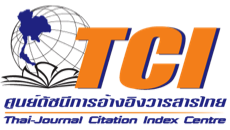ความคิดสร้างสรรค์และผลสัมฤทธิ์ทางการเรียนคณิตศาสตร์ของนักเรียนชั้นมัธยมศึกษาปีที่ 3 ในชั้นเรียนคณิตศาสตร์ที่ใช้การจัดการเรียนรู้ที่เน้นปัญหาเป็นฐาน (9th Grade Students’ Creative Thinking and Mathematics Achievement in a Mathematics Problem-Based Learning Classroom)
คำสำคัญ:
การเรียนรู้ที่เน้นปัญหาเป็นฐาน, ความคิดสร้างสรรค์, ผลสัมฤทธิ์ทางการเรียนคณิตศาสตร์ของนักเรียนชั้นมัธยมศึกษาปีที่ 3บทคัดย่อ
การวิจัยครั้งนี้มีจุดประสงค์เพื่อศึกษาความคิดสร้างสรรค์และผลสัมฤทธิ์ทางการเรียนคณิตศาสตร์ของนักเรียนชั้นมัธยมศึกษาปีที่ 3 ในชั้นเรียนคณิตศาสตร์ที่ใช้การจัดการเรียนรู้ที่เน้นปัญหาเป็นฐาน กลุ่มเป้าหมายเป็นนักเรียนชั้นมัธยมศึกษาปีที่ 3 จำนวน 1 ห้องเรียน (40 คน) ภาคเรียนที่ 2 ปีการศึกษา 2562 ระยะเวลา 4 สัปดาห์ เครื่องมือที่ใช้ในการวิจัยได้แก่ 1. แผนการจัดการเรียนรู้เน้นปัญหาเป็นฐาน เรื่อง ระบบสมการ (จำนวน 6 แผน แผนละ 100 นาที) มีค่า IOC ตั้งแต่ 0.67 ถึง 1.00 2. ผลงานของผู้เรียน ได้แก่ ใบกิจกรรมเดี่ยวและใบกิจกรรมกลุ่ม 3. แบบบันทึกการสอนของผู้สอน 4. บันทึกการสะท้อนคิดของนักเรียน 5. แบบวัดความคิดสร้างสรรค์ของผู้เรียนมีค่า IOC ตั้งแต่ 0.67 ถึง 1.00 และ 6. แบบวัดผลสัมฤทธิ์ทางการเรียนคณิตศาสตร์ ประกอบไปด้วยแบบทดสอบปรนัย 15 ข้อมีค่าความยากง่ายอยู่ระหว่าง 0.33 - 0.74 มีค่าอำนาจจำแนกอยู่ระหว่าง 0.31 - 0.59 และมีค่าความเชื่อมั่นเท่ากับ 0.71 และแบบทดสอบอัตนัย 5 ข้อ มีค่าความยากง่ายอยู่ระหว่าง 0.41 - 0.53 มีค่าอำนาจจำแนกอยู่ระหว่าง 0.39 - 0.51 และมีค่าความเชื่อมั่นเท่ากับ 0.66 ผลการวิจัยพบว่า ความคิดสร้างสรรค์ทางคณิตศาสตร์ของนักเรียนในภาพรวมอยู่ในระดับดีและมีคะแนนเฉลี่ยรวมเท่ากับ 2.03 โดยในด้านความคล่องในการคิด ความยืดหยุ่นในการคิดและความคิดละเอียดลอออยู่ในระดับดี โดยมีคะแนนเฉลี่ยเป็น 2.10, 2.00 และ 2.05 ตามลำดับ แต่ความคิดริเริ่มมีคะแนนเฉลี่ยออยู่ในระดับพอใช้ โดยมีคะแนนเฉลี่ยเป็น 1.97 นอกจากนี้ในส่วนของผลสัมฤทธิ์ทางการเรียนคณิตศาสตร์มีคะแนนเฉลี่ย 17.8 จากคะแนนเต็ม 25 คะแนน โดยมีนักเรียนที่ผ่านเกณฑ์มาตรฐานของโรงเรียนที่ร้อยละ 60 มากกว่าร้อยละ 70 ของจำนวนนักเรียนทั้งหมด
เอกสารอ้างอิง
อานนท์ ศักดิ์วรวิชญ์. (2560). 11 คุณลักษณะของคนไทย 4.0 ที่ต้องปฏิรูปจะช่วยให้ Thailand 4.0 เป็น ความจริง, สืบค้นเมื่อ 19 ตุลาคม 2562, จาก https://mgronline.com/daily/1509
Anggraeny, A. E. (2015). “Development of Mathematics Learning Tools with Problem Based Learning Approach to Improve Higher Order Thinking Ability”. In Seminar Nasional Matematika dan Pendidikan Matematika Uny: 83-92.
Don Treffinger. (1998). Assessing Creative Thinking. Sarasota: Center for Creative Learning.
Renzulli, J. S., & De Wet, C. F. (2010). “Developing creative productivity in young people through the pursuit of ideal acts of learning”. Nurturing creativity in the classroom: 24-72.
Othman, H., Salleh, B. M., & Sulaiman, A. (2013). “5 ladders of active learning: An innovative
learning steps in PBL process”. PBL Across Cultures: 245 –253.
Lince, R. (2016). “Creative thinking ability to increase student mathematical of junior high school by applying models numbered heads together”. Journal of Education and Practice 7(6): 206-212.
Masitoh, L. F., & Fitriyani, H. (2018). “Improving students’ mathematics self-efficacy through problem based learning”. Malikussaleh Journal of Mathematics Learning 1(1): 26-30.
Munandar. (2009). “Creativity and education: a study of the relationships between measures of creative thinking and a number of educational variables in Indonesian primary and junior secondary schools”, Doctoral dissertation 1(2): 124-138.
Nikmah. (2018). “Problem solving ability of seventh grade students viewed from geometric thinking levels in search solve create share learning model”. Unnes Journal of Mathematics Education 7(1): 8-16.
Pintér Krekić, V., & Ivanović, J. (2013). “Creativity strategy for mathematics instruction”. Croatian Journal of Education 15(2): 289-329.
Rosnawati, R. (2018). “Implementation of Problem-Based Learning in terms of Student Mathematical Creative Thinking”. Journal of Physics: Conference Series 18(1097): 1-5.
Sirait, A. R. (2018). “Analysis Difficulty of Mathematical Creative Thinking Ability Reviewed From Learning Styles Through Problem Based Learning”. Advances in Social Sciences Research Journal 5(10): 1397-1402.
Siswono, T. Y. E. (2011). “Level of student's creative thinking in classroom mathematics”. Educational Research and Reviews 6(7): 548.
Sternberg, R. J. (2003). Wisdom, intelligence, and creativity synthesized. Cambridge University Press.
Supianti, I. I., Kartasasmita, B. G., & Nurlaelah, E. (2019). “Teachers’ perspective on the application of information and communication technology (ICT) in mathematics learning”. In Journal of Physics 2(13212): 022107.
Suripah , F, & Retnawati, A. (2019). “The Effectiveness of Inquiry Learning Models on Students' Creative Thinking Ability in the Pythagorean Theorem Material”. Jurnal Pendidikan Matematika 3(2): 227-237.
Surya, E., Dermawan, D. A., & Syahputra, E. (2017). “The Efforts to Improving the Creative Thinking Ability Through Problem-Based Learning of Junior High School Students”. International Journal of Novel Research in Education and Learning 4(2): 2394-9686.
Tan, O. S., Chye, S., & Teo, C. T. (2009). “Problem-based learning and creativity: A review of the literature”. Problem-based learning and creativity: 15-38.
Uygun, N., & Tertemiz, N. I. (2014). “Effects of problem-based learning on student attitudes”, achievement and retention of learning in math course: 39(174).
Wayan NL, N., Fadiawati, N., & Jalmo, T. (2018). “Improving the Students’ Creative Thinking using Problem Based Worksheet on the Topic of Environmetal Pollution”. Jurnal Pendidikan Progresif 8(2): 127-137.





